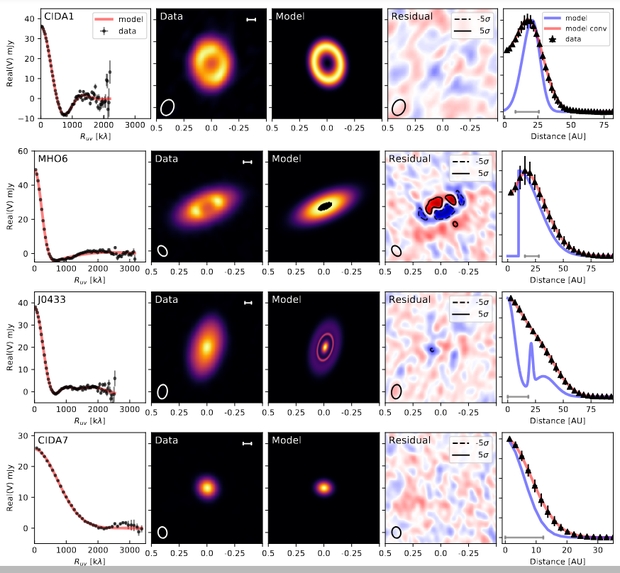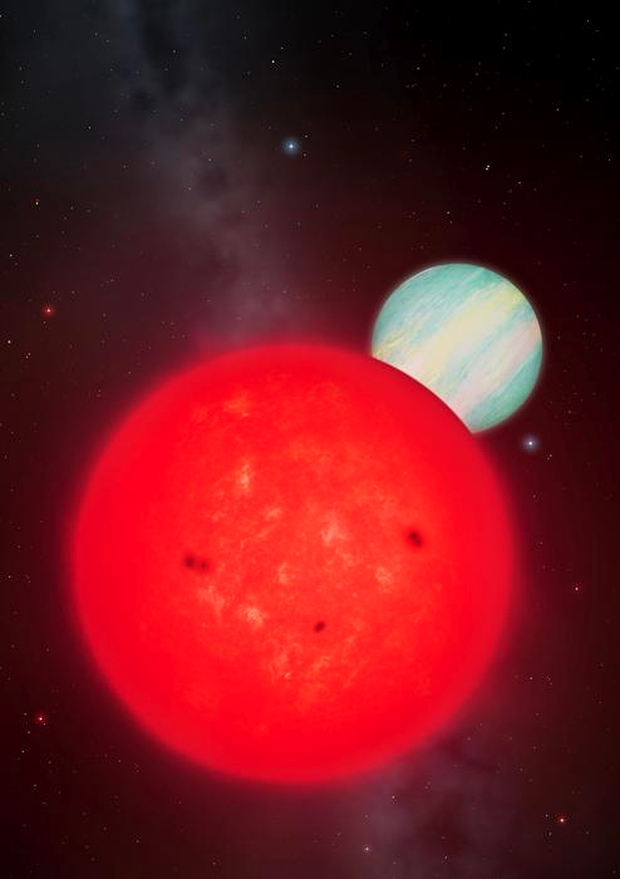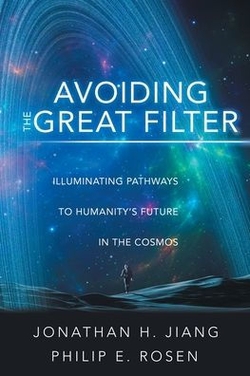The assumption that gas giant planets are unlikely around red dwarf stars is reasonable enough. A star perhaps 20 percent the mass of the Sun should have a smaller protoplanetary disk, meaning sufficient gas and dust to build a Jupiter-class world are lacking. The core accretion model (a gradual accumulation of material from the disk) is severely challenged. Moreover, these small stars are active in their extended youth, sending out frequent flares and strong stellar winds that should dissipate such a disk quickly. Gravitational instabilities within the disk are one possible alternative.
Planet formation around such a star must be swift indeed, which accounts for estimates as low as 1 percent of such stars having a gas giant in the system. Exceptions like GJ 3512 b, discovered in 2019, do occur, and each is valuable. Here we have a giant planet, discovered through radial velocity methods, orbiting a star a scant 12 percent of the Sun’s mass. Or consider the star GJ 876, which has two gas giants, or the exoplanet TOI-5205 b, a transiting gas giant discovered in 2023. Such systems leave us hoping for more examples to begin to understand the planet forming process in such a difficult environment.
Let me drop back briefly to a provocative study from 2020 by way of putting all this in context before we look at another such system that has just been discovered. In this earlier work, the data were gathered at the Atacama Large Millimeter/submillimeter Array (ALMA), taken at a wavelength of 0.87 millimeters. The team led by Nicolas Kurtovic (Max Planck Institute for Astronomy, Heidelberg) found evidence of ring-like structures in protoplanetary disks that extend between 50 and 90 AU out.

Image: This is a portion of Figure 2 from the paper, which I’m including because I doubt most of us have seen images of a red dwarf planetary disk. Caption: Visibility modeling versus observations of our sample. From left to right: (1) Real part of the visibilities after centering and deprojecting the data versus the best fit model of the continuum data, (2) continuum emission of our sources where the scale bar represents a 10 au distance, (3) model image, (4) residual map (observations minus model), (5) and normalized, azimuthally averaged radial profile calculated from the beam convolved images in comparison with the model without convolution (purple solid line) and after convolution (red solid line). In the right most plots, the gray scale shows the beam major axis. Credit: Kurtovic et al.
Gaps in these rings, possibly caused by planetary embryos, would accommodate planets of the Saturn class, and the researchers find that gaps formed around three of the M-dwarfs in the study. The team suggests that ‘gas pressure bumps’ develop to slow the inward migration of the disk, allowing such giant worlds to coalesce. It’s an interesting possibility, but we’re still early in the process of untangling how this works. For more, see How Common Are Giant Planets around Red Dwarfs?, a 2021 entry in these pages.
Now we learn of TOI-6894 b, a transiting gas giant found as part of Edward Bryant’s search for such worlds at the University of Warwick and the University of Liège. An international team of astronomers confirmed the find using telescopes at the SPECULOOS and TRAPPIST projects. The work appears in Nature Astronomy (citation below). Here’s Bryant on the scope of the search for giant M-dwarf planets:
“I originally searched through TESS observations of more than 91,000 low-mass red-dwarf stars looking for giant planets. Then, using observations taken with one of the world’s largest telescopes, ESO’s VLT, I discovered TOI-6894 b, a giant planet transiting the lowest mass star known to date to host such a planet. We did not expect planets like TOI-6894b to be able to form around stars this low-mass. This discovery will be a cornerstone for understanding the extremes of giant planet formation.”
TOI-6894 b has a radius only a little larger than Saturn, although it has only about half of Saturn’s mass. What adds spice to this particular find is that the host star is the lowest mass star found to have a transiting giant planet. In fact, TOI-6894 is only 60 percent the size of the next smallest red dwarf with a transiting gas giant. Given that 80 percent of stars in the Milky Way are red dwarfs, determining an accurate percentage of red dwarf gas giants is significant for assessing the total number in the galaxy.

Image: Artwork depicting the exoplanet TOI-6894 b around a red dwarf star. This planet is unusual because, given the size/mass of the planet relative to the very low mass of the star, this planet should not have been able to form. The planet is vary large compared to its parent star, shown here to scale. With the known temperature of the star, the planet is expected to only be approximately 420 degrees Kelvin at the top of its atmosphere. This means its atmosphere may contain methane and ammonia, amongst other species. This would make this planet one of the first planets outside the Solar System where we can observe nitrogen, which alongside carbon and oxygen is a key building block for life. Credit: University of Warwick / Mark Garlick.
TOI-6894 b produces deep transits and sports temperatures in the range of 420 K, according to the study. Clearly this world is not in the ‘hot Jupiter’ category. Amaury Triaud (University of Birmingham) is a co-author on this paper:
“Based on the stellar irradiation of TOI-6894 b, we expect the atmosphere is dominated by methane chemistry, which is exceedingly rare to identify. Temperatures are low enough that atmospheric observations could even show us ammonia, which would be the first time it is found in an exoplanet atmosphere. TOI-6894 b likely presents a benchmark exoplanet for the study of methane-dominated atmospheres and the best ‘laboratory’ to study a planetary atmosphere containing carbon, nitrogen, and oxygen outside the Solar System.”
Thus it’s good to know that JWST observations targeting the atmosphere of this world are already on the calendar within the next 12 months. Rare worlds that can serve as benchmarks for hitherto unexplained processes are pure gold for our investigation of where and how giant planets form.
The paper is Bryant et al., “A transiting giant planet in orbit around a 0.2-solar-mass host star,” Nature Astronomy (2025). Full text. The Kurtovic study is Kurtovic, Pinilla, et al., “Size and Structures of Disks around Very Low Mass Stars in the Taurus Star-Forming Region,” Astronomy & Astrophysics, 645, A139 (2021). Full text.



Is it not possible that the star and its planet were formed as a close binary? We have the case of LP 413-53AB which are 2 very cool stars orbiting just 1 million km from each other. Is it possible that TOI-6894 b was not formed by accretion from a disk but directly from the nebula material? The asymmetry of mass is common with most binaries. In this case it is too small to ignite as a star and is cool enough to maintain the carbon molecules like CH4 and nitrogen molecule NH3. Its low density compared to Saturn suggests no rocky core just light molecules and hydrogen in various states.
If so, it would solve the issue of how it accreted material, as the standard model for planet formation suggests.
I agree with this paper as old views, assumptions and opinions will become obsolete. There is nothing unusual if we stick to the first principles. Doubles stars close together have masses close to each other have a barycenter inside the star. They form from an accretion disk so a star with a planet with much smaller mass form even easier from an accretion disk. The closer location to a smaller mass star is not surprising since there is less gravity and a smaller accretion disk and system results.
So far oxygen seems to be undetected in exoplanets and oxygen in an Earth size, so the idea that planet in the life belt of a star could be discovered to have oxygen in its spectra is a smoking gun for life and we have not seen any false positives yet, but are still early in the exoplanet search.
Hi Paul
Yes while not predicted by standard core accretion models Giant planets do occur around small stars, more than our theories would expect. As Alex says binary accretion or disc instability could form these planets.
The interesting thing to ponder here are the Moon’s orbiting this planet, move it further away from the star to receive just the right amount of heat and light along with a Moon large enough to have an Atmosphere and you have an interesting place to study and visit.
Thanks Edwin
In any case, so far as red dwarfs and gas giant frequency is concerned, we have at least one case of a gas giant detection. The question remains whether it is
an aberration or not.
As to “thus far”, I would argue that the article has not provided the full basis. The authors explain that they reviewed TESS data of 90,000 red dwarfs – and ultimately located one red dwarf with a Saturn sized gas giant.
Now what is missing is an estimate of how many red dwarf exoplanets were identified from TESS data overall. Or, how many of the 90,000 red dwarfs failed to produce evidence of ANY transiting exoplanets. Does that really mean one gas giant for every 90,000 red dwarfs is a finding that will stand?
This result does not mean that the red dwarfs do not have any large exoplanets. Just that so far gas giant exoplanets did not pass through the window provided by a star behind them – or else did not cause an extinction deep enough to register on “photometers”. Or that the search lasted long enough to spot a Saturn sized object with a period longer than a year.
And in addition, as yet (we or I ) do not know how much of the TESS database correlates with doppler or radial velocity Or how long they were watched.
In the early days of exoplanet discovery (1990s), our picture of star systems seemed to be one loaded with G stars surrounded by eccentric, short period hot Jupiters. Those were the days all right. Large mass planets with eccentric orbits, which helped to make their stellar radial velocity changes stand out; something that served up few exo-earths in its heyday.
If we were to get a jovian sized planet transiting a red dwarf at the equator, the extinction dip would be about as deep as they come, assuming radii ratios of
0.05 to 0.2 or reductions of 2.5 to 4 percent. But if red dwarf systems with gas giant planets are constructed like this solar system – generally – the orbital periods will be much longer than those characterized by Trappist 1. Jupiter’s period is about 12 x Earth’s and Saturn’s about 30. Gas giants would form and perhaps remain out beyond the snow line. If Trappist transits occur in intervals of a few days, researchers looking for cold gas giants should expect 10 to 30 x the interval. That might be an obstacle to a research proposal in itself.
Then as researchers’ interest in one technique or another shifts over time, I wonder what the ratio or RV studies is these days to that of exoplanet transits?
Of course, the research conclusion about gas giants and red dwarfs might well be valid. But it is also likely that it is often harder to find things one is not looking for. Consequently, the next gas giant transiting an M star might be detected by
X . E. Dent et al.